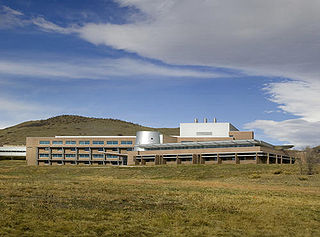Related Research Articles

The National Renewable Energy Laboratory (NREL) in the US specializes in the research and development of renewable energy, energy efficiency, energy systems integration, and sustainable transportation. NREL is a federally funded research and development center sponsored by the Department of Energy and operated by the Alliance for Sustainable Energy, a joint venture between MRIGlobal and Battelle. Located in Golden, Colorado, NREL is home to the National Center for Photovoltaics, the National Bioenergy Center, and the National Wind Technology Center.

Rural electrification is the process of bringing electrical power to rural and remote areas. Rural communities are suffering from colossal market failures as the national grids fall short of their demand for electricity. As of 2019, 770 million people live without access to electricity – 10.2% of the global population. Electrification typically begins in cities and towns and gradually extends to rural areas, however, this process often runs into obstacles in developing nations. Expanding the national grid is expensive and countries consistently lack the capital to grow their current infrastructure. Additionally, amortizing capital costs to reduce the unit cost of each hook-up is harder to do in lightly populated areas. If countries are able to overcome these obstacles and reach nationwide electrification, rural communities will be able to reap considerable amounts of economic and social development.

There are several solar power plants in the Mojave Desert which supply power to the electricity grid. Insolation in the Mojave Desert is among the best available in the United States, and some significant population centers are located in the area. These plants can generally be built in a few years because solar plants are built almost entirely with modular, readily available materials. Solar Energy Generating Systems (SEGS) is the name given to nine solar power plants in the Mojave Desert which were built in the 1980s, the first commercial solar plant. These plants have a combined capacity of 354 megawatts (MW) which made them the largest solar power installation in the world, until Ivanpah Solar Power Facility was finished in 2014.

The China Village Electrification Program was a scheme to provide renewable electricity to 3.5 million households in 10,000 villages by 2010. This was to be followed by full rural electrification using renewable energy by 2015.

According to data from the US Energy Information Administration, renewable energy accounted for 8.4% of total primary energy production and 21% of total utility-scale electricity generation in the United States in 2022.

China is both the world's largest energy consumer and the largest industrial country, and ensuring adequate energy supply to sustain economic growth has been a core concern of the Chinese Government since the founding of the People's Republic of China in 1949. Since the country's industrialization in the 1960s, China is currently the world's largest emitter of greenhouse gases, and coal in China is a major cause of global warming. However, from 2010 to 2015 China reduced energy consumption per unit of GDP by 18%, and CO2 emissions per unit of GDP by 20%. On a per-capita basis, China was only the world's 51st largest emitter of greenhouse gases in 2016. China is also the world's largest renewable energy producer, and the largest producer of hydroelectricity, solar power and wind power in the world. The energy policy of China is connected to its industrial policy, where the goals of China's industrial production dictate its energy demand managements.
The electricity sector in Honduras has been shaped by the dominance of a vertically integrated utility; an incomplete attempt in the early 1990s to reform the sector; the increasing share of thermal generation over the past two decades; the poor financial health of the state utility Empresa Nacional de Energía Eléctrica (ENEE); the high technical and commercial losses in transmission and distribution; and the low electric coverage in rural areas

The electricity sector in Colombia is dominated by large hydropower generation (65%) and thermal generation (35%). Despite the country's large potential for new renewable energy technologies, this potential has been barely tapped. A 2001 law designed to promote alternative energies lacks certain key provisions to achieve this objective, such as feed-in tariffs, and has had little impact so far. Large hydropower and thermal plants dominate the current expansion plans. The construction of a transmission line with Panama, which will link Colombia with Central America, is underway.

The electricity sector in Bolivia is dominated by the state-owned ENDE Corporation, although the private Bolivian Power Company is also a major producer of electricity. ENDE had been unbundled into generation, transmission and distribution and privatized in the 1990s, but most of the sector was re-nationalized in 2010 (generation) and 2012.
The electricity sector in Argentina constitutes the third largest power market in Latin America. It relies mostly on thermal generation and hydropower generation (36%). The prevailing natural gas-fired thermal generation is at risk due to the uncertainty about future gas supply.
The electricity sector in Peru has experienced large improvements in the past 15 years. Access to electricity has increased from 45% in 1990 to 96.4% in 2018, while service quality and efficiency of service provision improved. These improvements were made possible through privatizations following reforms initiated in 1992. At the same time, electricity tariffs have remained in line with the average for Latin America.
China has set the goal of attaining one percent of its renewable energy generation through bioenergy in 2020.

Nicaragua is the country in Central America with the lowest electricity generation, as well as the lowest percentage of population with access to electricity. The unbundling and privatization process of the 1990s did not achieve the expected objectives, resulting in very little generation capacity added to the system. This, together with its high dependence on oil for electricity generation, led to an energy crisis in 2006 from which the country has not fully recovered yet.

Solar power includes solar farms as well as local distributed generation, mostly on rooftops and increasingly from community solar arrays. In 2023, utility-scale solar power generated 164.5 terawatt-hours (TWh), or 3.9% of electricity in the United States. Total solar generation that year, including estimated small-scale photovoltaic generation, was 238 TWh.
State Electricity Regulatory Commission was a government agency responsible for the administration and regulation of the electricity and power industry in the People's Republic of China. This includes regulating the development of electricity markets, advising the National Development Reform Commission on the setting tariffs, while NDRC actually sets the tariffs, transmission, distribution, safety standards, technical standards, business licenses, environmental laws and development of the industry. Its functions were later folded into the National Energy Administration.
Benin is a coastal country located in the Gulf of Guinea in Western Africa, which is a resource rich region. Energy in Benin has a diverse energy mix and takes several forms including: solar, wind, hydropower, biomass, fossil resources, and mineral resources. Out of this energy mix, about 60% of energy comes from biomass. Benin is also dependent on energy imports from Ghana and Côte d'Ivoire. While power plants and other energy facilities were built in the 1950s and 1960s, the lack of investment has led to deterioration over time. Similarly, its location in the Gulf of Guinea has led to an attempt of oil production starting in the late 1980s. However, due to unprofitable operations, oil production halted in 1998.
Energy use and development in Africa varies widely across the continent, with some African countries exporting energy to neighbors or the global market, while others lack even basic infrastructures or systems to acquire energy. The World Bank has declared 32 of the 48 nations on the continent to be in an energy crisis. Energy development has not kept pace with rising demand in developing regions, placing a large strain on the continent's existing resources over the first decade of the new century. From 2001 to 2005, GDP for over half of the countries in Sub Saharan Africa rose by over 4.5% annually, while generation capacity grew at a rate of 1.2%.

Most of Kenya's electricity is generated by renewable energy sources. Access to reliable, affordable, and sustainable energy is one of the 17 main goals of the United Nations’ Sustainable Development Goals. Development of the energy sector is also critical to help Kenya achieve the goals in Kenya Vision 2030 to become a newly industrializing, middle-income country. With an installed power capacity of 2,819 MW, Kenya currently generates 826 MW hydroelectric power, 828 geothermal power, 749 MW thermal power, 331 MW wind power, and the rest from solar and biomass sources. Kenya is the largest geothermal energy producer in Africa and also has the largest wind farm on the continent. In March 2011, Kenya opened Africa's first carbon exchange to promote investments in renewable energy projects. Kenya has also been selected as a pilot country under the Scaling-Up Renewable Energy Programmes in Low Income Countries Programme to increase deployment of renewable energy solutions in low-income countries. Despite significant strides in renewable energy development, about a quarter of the Kenyan population still lacks access to electricity, necessitating policy changes to diversify the energy generation mix and promote public-private partnerships for financing renewable energy projects.

Renewable energy in Bangladesh refers to the use of renewable energy to generate electricity in Bangladesh. The current renewable energy comes from biogas that is originated from biomass, hydro power, solar and wind. According to National database of Renewable Energy total renewable energy capacity installed in Bangladesh 1374.68 MW.
Concept of smart villages is a global modern approach for off-grid communities. Vision behind this concept is to assist the policy makers, donors and socio-economic planner for rural electrification worldwide.
References
- 1 2 3 Renewables Global Status Report 2006 Update Archived July 18, 2011, at the Wayback Machine , REN21 , published 2006, accessed 2007-05-16
- 1 2 Township Electrification Program (fact sheet), National Renewable Energy Laboratory , published April 2004, accessed 2007-05-16